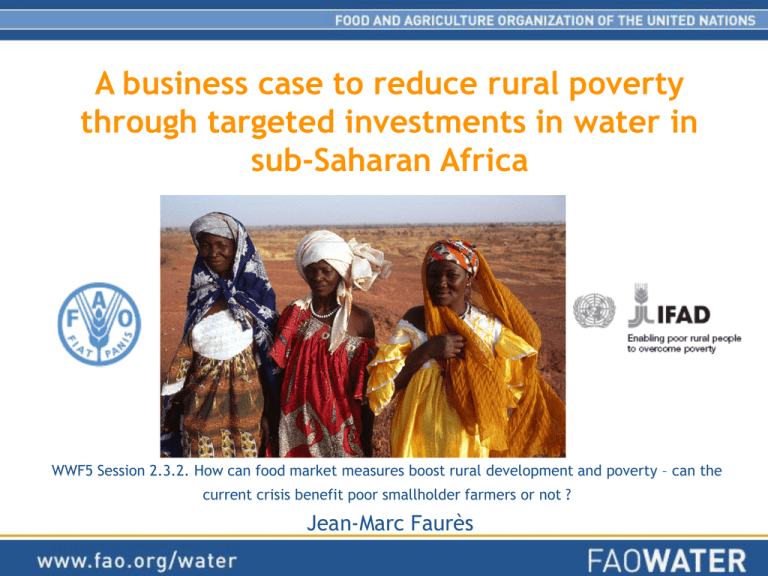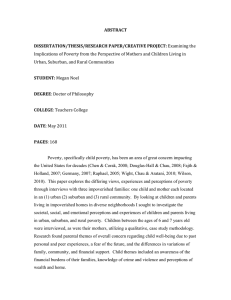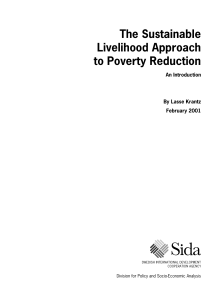A business case to reduce rural poverty sub-Saharan Africa
advertisement

A business case to reduce rural poverty through targeted investments in water in sub-Saharan Africa WWF5 Session 2.3.2. How can food market measures boost rural development and poverty – can the current crisis benefit poor smallholder farmers or not ? Jean-Marc Faurès Guiding questions • Where and how should investments in water-related interventions be done to effectively boost livelihoods and reduce poverty in rural areas ? • What is the link between access to water and rural livlihood ? • Where is water a constraint to agricultural • production and a priority for sustainable rural livelihoods ? Who are the target beneficiaries and where are they? Approach: Livelihood zoning Areas where people share similar livelihood patterns: • Common key biophysical determinants • Climate • Resource endowment • Agroecological conditions • Common key socioeconomic determinants: • Population structure and dynamics • Household livelihood strategies and constraints • Main sources of food and income • Institutions Regional study: sub-Saharan Africa Main livelihood zones in SSA Criteria adopted to assess poverty reduction potential • Poverty incidence: • absolute number and percentage of rural poor • Water as limiting factor for livelihoods: • Inter-annual variability of water (prevalence of droughts) • Water is entry point for main livelihood activities • Potential for water control development: • availability of additional water for agriculture and other usages Where are the rural poor in SSA ? Vulnerability to climate variability Burkina Faso: rainfall and cereal production Poverty reduction potential across livelihood zones Poverty reduction potential across livelihood zones Water interventions in support to rural livelihoods A necessary focus on smallholder farmers Adapting approaches to smallholder’s conditions •Operational simplicity •Reduced number of users •No need for external support for operation •Low maintenance requirements •Limited physical and financial capital requirements •Not always low cost or best B/C ratio Small, divisible, farmer controlled water supply systems A typology of investment options 1.Manage soil moisture in rainfed areas 2.Invest in small scale water harvesting infrastructure 3.Promote small-scale community-based irrigation 4.Improve existing irrigation systems 5.Improve water control for peri-urban producers 6.Invest in water for livestock production 7.Facilitate multiple use of water Planning: assessing the potential of interventions Applying the three criteria: • Potential for development (physical) • Water as limiting factor for livelihoods • Poverty incidence Potential and costs of interventions In summary Number of potential beneficiaries 245 million 58 % of rural population Cost 85 billion US$ 350 US$/person Essential conditions for success Essential conditions for success 1.Ensuring enabling governance and policies • Strengthening local institutions, conducive rural policies legal framework 2.Securing access to markets • incl. information on prices 3.Providing complementary physical infrastructure • Roads, market places, storage, refrigeration 4.Securing access to land and water 5.Preventing soil degradation and restoring fertility 6.Providing targeted subsidies and adapted financial packages • Including crop insurances 7.Investing in human capital • Access to knowledge, training, gender considerations. Adapting agricultural support strategies Adapting financial services “Propositions” (specifically for sub-Saharan Africa) i. When planning water interventions in SSA, consider different target groups and different objectives: i. Filling food production gap, contributing to economic growth: emerging farmers possibly with good connections to markets ii. Rural poverty reduction: focus on traditional smallholders farmers, fishers and herders with little connection to markets. Interventions in water primarily focusing on increased resilience of rural farmers and reduce their vulnerability to climate variability ii. Context-specificity: water-related interventions must be adapted to livelihood situations and contexts, must consider basic needs and all productive uses of water. iii.Conducive policy environment necessary, including: food chain approach for major staple commodities (rice, maize); adapted financial packages; land tenure iv. Combine water control and soil fertility management



